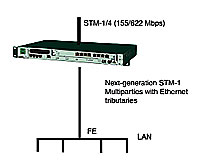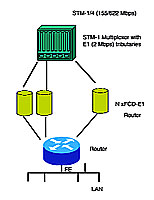WEB LINK - http://www.expresscomputeronline.com/20050829/management03.shtml
CXO Accent
Converging the LAN and WAN infrastructure
The next time you order a WAN link, ask for an Ethernet link based on GFP, VCAT and LCAS. You will save a ton of money and operational headaches.
 |
|
Dr Kumar Sivarajan
|
The data network of a typical medium-to-large enterprise needs to satisfy three different interconnection objectives. First, it has to interconnect users within a single building or campus. This is typically referred to as Local Area Network or LAN. Many companies have users in multiple locations that may be in the same city, different cities, or even in different countries. They may also need to connect to their customer sites. Therefore, the second objective of any enterprise’s network is to interconnect users across these geographically-dispersed sites. The essential difference between this and the first requirement is that connectivity is now through one or more service providers. This network is typically referred to as Wide Area Network or WAN. Finally, users need connectivity to the Internet and this means a connection to an Internet Service Provider (ISP). This is also typically considered a part of the enterprise WAN.
The LAN is entirely based on Ethernet interfaces. Fast Ethernet (FE, 100 Mbps) is used widely, while Gigabit Ethernet (GigE, 1,000 Mbps) is becoming increasingly prevalent. Small LANs may consist of users connected directly to an Ethernet switch. For larger networks, routers are used to provide additional functions, for example firewalls between different groups, but the interfaces used in this case are also Ethernet. Ethernet technology is thus widely deployed in enterprises and well understood by their IT departments. It is also extremely cost-effective due to the enormous volumes for these interfaces.
However, the WAN interfaces in the enterprise need to be compatible with the service provider networks. These networks are almost entirely based on the Synchronous Digital Hierarchy (SDH) or Synchronous Optical Network (SONET) standards developed by the International Telecommunications Union (ITU). This is true for in-country networks of all major service providers across the globe as well as the service provider networks between countries. These SDH/SONET networks evolved from the need to efficiently support voice that formed the bulk of the service provider traffic until a few years ago. Thus, their interfaces are designed to efficiently support voice but the same interfaces are now used to support data. For example, the typical interface speeds are 2 Mbps (E1), 34 Mbps (E3) and 45 Mbps (DS3) which are the rates used to multiplex voice circuits into SDH equipment. These are also the data rates of leased lines that can be obtained from service providers to connect the different sites of an enterprise, or to connect the enterprise to an ISP. This dichotomy of interfaces—Ethernet at 10/100/1000 Mbps in the LAN and E1/E3/DS3 at 2/34/45 Mbps from SDH equipment in the WAN—results in the need to maintain separate equipment for LAN and WAN with an increase not only in capital costs but also in operational costs including training maintenance personnel.
Typically, a router is used to interface between the LAN and WAN using an Ethernet interface to connect to the LAN and WAN interfaces at 2 or 34 or 45 Mbps to connect to the service provider’s SDH network. Unfortunately, even this is not enough in many instances as the same 2 Mbps interfaces in the router and the SDH equipment conform to two different ITU standards—V.35 for the router and G.703 for the SDH equipment. Thus, another ‘converter device’ is typically required to convert between these two standards.
A data rate of 2 Mbps is inadequate for many enterprises, but at the same time a data rate of 34 or 45 Mbps is too expensive. Thus, for someone needing, say 10 Mbps, the only option is to get five 2 Mbps interfaces, using five ports on the router and five FCDs, and using the router to split the Ethernet data from the LAN among these interfaces. This not only involves more capital expenditure, but also creates operational problems.
 |
|
Equipment needed to connect an enterprise LAN to the
WAN at data rates of a few Mbps, using next-generation SDH equipment from
the service provider supporting Ethernet interfaces
|
Recently, ITU recognised this problem and evolved a set of standards for supporting Ethernet interfaces directly on SDH equipment. Equipment supporting these interfaces is typically dubbed ‘Next-Generation SDH.’ It permits drastic simplification of the networking gear used to connect the LAN to the WAN. Now the same Ethernet interface used in the LAN is used to connect to the WAN as well. This Ethernet interface can be connected to a router in the enterprise or to an Ethernet switch. The choice is dictated not by any requirements imposed by the WAN infrastructure, but by the functionality needed by the different sites being interconnected. Thus, the equipment required in the enterprise is the same whether to connect to another user in the same floor/building or to users at a site located across the globe.
 |
|
Typical equipment needed to connect an enterprise LAN
to the WAN at data rates of a few Mbps, using multiple 2 Mbps links
|
Note that this convergence of the LAN and WAN network equipment required in the enterprise does not depend on the convergence of the technologies used to build the LAN and WAN. There are some efforts to deploy Ethernet switching technologies in the service provider networks, but these are not relevant to the enterprise user. What matters to businesses is not how the service provider network is built, but what interfaces it provides to them to connect. If the interfaces are Ethernet, businesses need not maintain two separate network infrastructures—one for LAN and another for WAN.
What are these new ITU standards that accomplish this? There are actually three of them that address the different components required to achieve this functionality. The first is Generic Framing Protocol (GFP) that frames the Ethernet data into a form suitable for transmission over SDH. The second is Virtual Concatenation (VCAT) that allows multiple SDH ‘channels’ (e.g., multiple 2 Mbps circuits) to be combined into a single ‘link.’ The last is Link Capacity Adjustment Scheme (LCAS), which allows the size of such a GFP/VCAT link to be varied by hitless addition and removal of one or more constituent channels.
So the next time you order a WAN link for your enterprise network from a service provider, ask for an Ethernet link based on GFP, VCAT and LCAS. You will save operational headaches and a ton of money.
The author is Chief Technology Officer, Tejas Networks. He can be reached at kumar@tejasnetworks.com